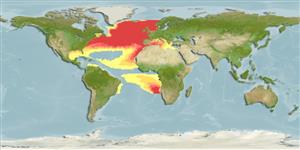Actinopterygii (peixes com raios nas barbatanas) >
Beloniformes (Needle fishes) >
Scomberesocidae (Sauries)
Etymology: Scomberesox: Latin, scomber = mackerel + Esox, the old name for "pike" (Ref. 45335).
Ambiente / Clima / Intervalo
Ecologia
; marinhas; oceanódromo (Ref. 51243); intervalo de profundidade 0 - 30 m (Ref. 6531). Subtropical, preferred 21°C (Ref. 107945); 66°N - 22°S, 98°W - 36°E
Arctic (Ref. 43202). North Atlantic. Eastern Atlantic: Iceland, Norway and Denmark (rarely), along British Isles into Baltic Sea and throughout the Mediterranean, Adriatic and Aegean seas to Morocco. Western Atlantic: Gulf of St. Lawrence, Canada to North Carolina, USA and Bermuda (Ref. 7251). Highly migratory species, Annex I of the 1982 Convention on the Law of the Sea (Ref. 26139).
Length at first maturity / Tamanho / Peso / Idade
Maturity: Lm 26.5, range 25 - ? cm
Max length : 50.0 cm TL macho/indeterminado; (Ref. 7251); common length : 32.0 cm TL macho/indeterminado; (Ref. 3397)
Oceanic, schooling and gregarious. Occasionally shoals close to shore in large numbers (Ref. 9987). Feeds on zooplankton and fish larvae (Ref. 9987); food also includes fish eggs and small fishes (Ref. 5951). Preyed upon by fish, including tunas, marlin bluefish and cod (Ref. 9987); also pollock, dolphins and porpoises (Ref. 5951). It is an under-exploited fish in many parts of its range and suitable for canning and other inexpensive uses (Ref. 9987). Often leap of the water when chased by enemies (Ref. 35388).
Distinct pairing (Ref. 205). Presence of asynchronous oocyte development in the ovaries (Ref. 109439).
Wisner, R.L., 1990. Scomberesocidae. p. 598-603. In J.C. Quero, J.C. Hureau, C. Karrer, A. Post and L. Saldanha (eds.) Check-list of the fishes of the eastern tropical Atlantic (CLOFETA). JNICT, Lisbon; SEI, Paris; and UNESCO, Paris. Vol. 2. (Ref. 6531)
Categoria na Lista Vermelha da IUCN (Ref. 115185)
CITES (Ref. 94142)
Not Evaluated
Ameaça para o homem
Harmless
Utilização humana
Pescarias: pouco comercial; isco: occasionally
Mais informação
ColaboradoresFotografiasStamps, CoinsSonsCiguateraVelocidadeTipo de nataçãoÁrea branquialOutras referênciasCérebrosVisão
Ferramentas
Relatórios especiais
Descarregue XML
Fontes da internet
